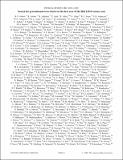Search for gravitational-wave bursts in the first year of the fifth LIGO science run
Author(s)
Zucker, Michael E.; Wipf, Christopher C.; Weiss, Rainer; Waldman, Samuel J.; Stein, Leo Chaim; Stein, Andrew J.; Smith, Nicolas de Mateo; Shoemaker, David H.; Shapiro, B.; Sarin, P.; Mittleman, Richard K.; Mavalvala, Nergis; Mason, Kenneth R.; Markowitz, Jared John; MacInnis, Myron E.; Katsavounidis, Erotokritos; Hughey, Brennan J.; Harry, Gregory; Grimaldi, F.; Goda, K.; Fritschel, Peter K.; Foley, Stephany; Evans, Matthew J.; Duke, I.; Donovan, Frederick J.; Corbitt, Thomas R.; Cao, Junwei; Brunet, G.; Bodiya, Timothy Paul; Blackburn, Lindy L.; Barsotti, Lisa; ... Show more Show less
DownloadAbbott-2009-Search for gravitational-wave bursts in the first year of the fifth LIGO science run.pdf (1.586Mb)
PUBLISHER_POLICY
Publisher Policy
Article is made available in accordance with the publisher's policy and may be subject to US copyright law. Please refer to the publisher's site for terms of use.
Terms of use
Metadata
Show full item recordAbstract
We present the results obtained from an all-sky search for gravitational-wave (GW) bursts in the 64–2000 Hz frequency range in data collected by the LIGO detectors during the first year (November 2005—November 2006) of their fifth science run. The total analyzed live time was 268.6 days. Multiple hierarchical data analysis methods were invoked in this search. The overall sensitivity expressed in terms of the root-sum-square (rss) strain amplitude h[subscript rss] for gravitational-wave bursts with various morphologies was in the range of 6×10[superscript -22] Hz[superscript -1/2] to a few×10-[superscript 21] Hz[superscript -1/2]. No GW signals were observed and a frequentist upper limit of 3.75 events per year on the rate of strong GW bursts was placed at the 90% confidence level. As in our previous searches, we also combined this rate limit with the detection efficiency for selected waveform morphologies to obtain event rate versus strength exclusion curves. In sensitivity, these exclusion curves are the most stringent to date.
Date issued
2009-11Department
Massachusetts Institute of Technology. Department of Physics; MIT Kavli Institute for Astrophysics and Space ResearchJournal
Physical Review D
Publisher
American Physical Society
Citation
LIGO Scientific Collaboration et al. “Search for gravitational-wave bursts in the first year of the fifth LIGO science run.” Physical Review D 80.10 (2009): 102001. © 2009 The American Physical Society
Version: Final published version
Other identifiers
LIGO Laboratory Document No. LIGO-P080056-v12
ISSN
1550-2368
1550-7998